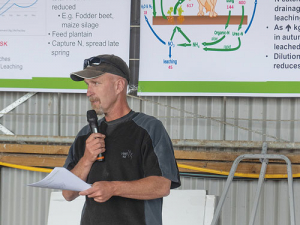Science Snippet: The complexities of vineyard nitrogen nutrition
Di-ammonium phosphate is frequently added to grape juice at the start of fermentation to ensure yeast have adequate nitrogen to complete fermentation.
 Sharemilker Tony Coltman, the first farmer signed up for Meeting a Sustainable Future project speaks at the programme launch.
Sharemilker Tony Coltman, the first farmer signed up for Meeting a Sustainable Future project speaks at the programme launch.
Farmers will have to look at their fundamental farming systems if they are to meet future nitrogen leaching limits.
Farmers might not have to move completely away from “the philosophies we all grew up with,” says DairyNZ science manager Dave McCall, “but we are going to have to dig deeper than a few small tweaks”.
McCall was speaking at the launch of a new DairyNZ project — Meeting a Sustainable Future — aimed at helping farmers in Canterbury’s Hinds and Selwyn catchments to remain profitable while meeting new nitrogen loss limits under the Canterbury Land and Water Regional Plan (LWRP).
Under the LWRP, Selwyn farmers must reduce N losses by 30% by 2022, and in Hinds by 15% by 2025, 25% by 2030 and 36% by 2035.
The project was launched at a well-attended field day on the Canlac Holdings farm at Dunsandel, in the Selwyn Catchment, run by sharemilker Tony Coltman.
McCall told the gathering he was there to bring confidence that farmers can meet the new limits.
He said the first thing to know is that the more nitrogen that comes onto a farm, the more will be leached out. The question is how much nitrogen is converted into product.
“The poorest conversion is about 25% of the nitrogen that comes into the farm goes out the gate, and at best — in exceptional circumstances — you might get over 40-45% of that nitrogen going out the gate. That’s what we’ve got to manage.”
Fertiliser and feed are the two biggest nitrogen inputs.
“If everyone understands their nitrogen surplus, that’s a good start,” said McCall.
DairyNZ aims to recruit about 30 farmers, take the science to them and “co-develop” practical solutions. Science has some of the knowledge but farmers also have a lot of knowledge, McCall said.
“We want to get you to understand what we understand, and then we want to work with you one-on-one to put what we know into the context of what you want to do on your farm.”
In return for that one-on-one help, those farmers would then pass their new knowledge on to others, said McCall.
“There’s more than one way of skinning the cat here and one size doesn’t fit all. So we want to provide a bunch of examples that other farmers can come along to and listen to on days like this and decide ‘this is how I want to do it’.”
There would not be only one solution, said McCall.
Talk of too high a stocking rate being the problem or a lower stocking rate being the answer “drives me nuts,” he said. Whether high or low, the solution will be to match feed supply and demand in a way that doesn’t introduce too much nitrogen when it is not wanted.
Canlac is one of the benchmark farms used by the Lincoln University Dairy Farm to judge its performance; it consistently comes in among the top 5% in operating profit – even while Coltman has managed to reduce N leaching significantly towards his 2022 target with a variety of measures including revised irrigation and reduced fertiliser use.
The farm has also taken part in the Forages for Reduced Nitrate Leaching project, and Coltman has sown plantain in his pastures.
Plantain’s lower nitrogen content means less nitrogen in urine, and it has a diuretic effect which further dilutes it. The plant’s roots also appear to have some beneficial effect as a denitrification inhibitor in the soil, which is the subject of further research.
The Meeting a Sustainable Future project is also supported by the Canterbury Dairy Leaders Group, whose chairman Alister Body said it will provide leadership for all farmers on this challenge.
“This work is a great way for Selwyn and Hinds dairy farmers, and others nationally, to watch and learn about the best options to reduce nitrogen losses and meet the future goals,” said Body. “It will be very interesting to follow.”
South Waikato farm manager Ben Purua’s amazing transformation from gang life to milking cows was rewarded with the Ahuwhenua Young Maori Farmer award last night.
Bankers have been making record profits in the last few years, but those aren’t the only records they’ve been breaking, says Federated Farmers vice president Richard McIntyre.
The 2023-24 season has been a roller coaster ride for Waikato dairy farmers, according to Federated Farmers dairy section chair, Mathew Zonderop.
Ministry for Primary Industries (MPI) director general Ray Smith says job cuts announced this morning will not impact the way the Ministry is organised or merge business units.
Scales Corporation is acquiring a number of orchard assets from Bostock Group.
Family and solidarity shone through at the 75 years of Ferdon sale in Otorohanga last month.
OPINION: Scientists claim to have found a new way to make a substitute for cow's milk that could have a…
OPINION: The Irish have come up with a novel way to measure cow belching, which is said to account for…